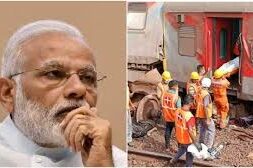
Manas Dasgupta
NEW DELHI, June 3: The engine drivers and guards of both the passenger trains involved in the Odisha train accident were injured and are being treated in different hospitals, a railway official said on Saturday.
The engine driver and the guard of the goods train, however, escaped unhurt, the official added. Coromandel Express’s loco pilot and his assistant as well as the guard and Bengaluru-Howrah Superfast Express’s guard were on the injured list.
“The loco pilot, assistant loco pilot and the guard of Coromandel Express and the guard of the Bengaluru-Howrah Express are being treated in different hospitals,” senior divisional commercial manager of South Eastern Railway’s Kharagpur division, Rajesh Kumar, said.
The horrific accident taking a toll of at least 261 lives and injuring some 900 passengers, many of them critically, however, has shifted the attention from modernisation to safety. India’s vast rail network is undergoing a $30 billion transformation with gleaming new trains and modern stations but Friday’s deadly train accident shows more attention should be paid to safety, experts said.
Indian Railways runs the fourth largest train network in the world. It transports 13 million people every day and moved nearly 1.5 billion tonnes of freight in 2022. Long-considered the lifeline of the world’s most populous country, the 170-year-old system has seen rapid expansion and modernisation under Prime Minister Narendra Modi’s push to boost infrastructure and connectivity in the fast-growing economy.
This year, the government made a record 2.4-trillion-rupee ($30 billion) capital outlay for the railways, a 50 per cent increase over the previous fiscal year, to upgrade tracks, ease congestion and add new trains.
A new, semi-high-speed train built in India and called the “Vande Bharat Express” is showcased as evidence of this modernisation, with Modi himself flagging off the first journeys of many of the trains around the country. But the Odisha accident has given a jolt to the authorities.
“The safety record has been improving over the years but there is more work to do,” said some experts. The railways have been introducing more and more trains to cope with soaring demand but the workforce to maintain them has not kept pace with it, the experts point out.
Workers are not trained adequately or their workload is too high, and they don’t get enough rest. The east coast route on which Friday’s crash occurred, is one of the country’s oldest and busiest, as it also carries much of India’s coal and oil freight. “These tracks are very old … the load on them is very high, if maintenance is not good, failures will happen,” the experts said.
Indian Railways maintains that safety has always been a key focus, and points to its low accident rate over the years. “This question (on safety) is arising because there has been one incident now. But if you see the data, you will see that there have been no major accidents for years,” a railways ministry spokesperson said.
The number of accidents per million train kilometres, a gauge of safety, had fallen to 0.03 in fiscal 2021-22 from 0.10 in 2013-14, the spokesperson said. A 1-trillion-rupee, five-year safety fund created in 2017-18 has been extended for another five years from 2022-23, with a further 450 billion rupees of funding, after the first plan led to an “overall improvement in safety indicators”, he added.
“Some malfunction has happened and that the inquiry will reveal,” he said, referring to Friday’s crash. “We will find out why it happened and how it happened.”
Some other experts point out that the Indian Railways had been working on safety mechanisms such as anti-collision devices and emergency warning systems but have been slow to install them across the network. “They will always tell you that accidents are at a very manageable level because they talk about them in terms of percentages,” he said, adding that in recent years the focus has been more on new trains and modern stations and not as much on tracks, signalling systems and asset management. “This accident brings out the need to focus more on these aspects,” he said.
Terming the horrific train accident in Odisha the ‘biggest of the century’, West Bengal chief minister Mamata Banerjee who met Minister for Railways Ashwini Vaishnaw on Saturday highlighted the safety aspect and said the crash could have been averted if trains were equipped with the anti-collision system.
“Coromandel is one of the best express trains. I was the Railway Minister thrice. From what I saw, this is the biggest railway accident of the 21st century. Such cases are handed over to Railway’s safety commission and they investigate and give a report. There was no anti-collision device on the train, as far as I know. Had the device been on the train, this would not have happened. The dead can’t be brought back but now our work is rescue operation and restoration of normalcy,” Mamata Banerjee said while addressing the reporters in the presence of the Railway minister. Banerjee had reached the accident site on Saturday morning.













